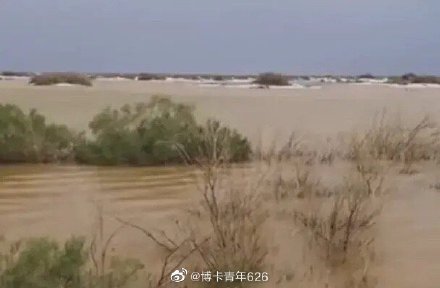
[Epoch Times, July 31, 2021]Extreme climates on the mainland are frequent. Recently, a rare flood occurred in the Taklimakan Desert in Xinjiang, with a flooded area of more than 300 square kilometers. According to reports, 30,000 sets of equipment and nearly 50 exploration vehicles of Sinopec were flooded.
According to Caixin.com, on July 19, heavy rain fell in the Dinaer section of the Tianshan Mountains in Luntai County, Xinjiang. In addition to the melting snow in the Tianshan Mountains in summer, seasonal floods were formed. The snow-melting floods in Tianshan hit Northwest Sinopec. In an exploration area of an oil field, there is a vast ocean in the desert. The roads in the oil area have broken dams and telephone poles are inclined.
A person familiar with the situation at the No. 1 Oil Production Plant of Sinopec Northwest Oilfield (hereinafter referred to as the No. 1 Oil Production Plant) said that the oil area was flooded in mid-July. The rain stopped recently and the desert seepage quickly, but the site was muddy. The ice and snow in Tianshan Mountains will continue to melt in the summer, and the superimposition of rain for consecutive days is the main cause of the accident. The follow-up will depend on whether it rains again.
Sinopec’s 30,000 sets of equipment and nearly 50 exploration vehicles were flooded, with a flooded area of more than 300 square kilometers
The most affected by the flooding accident was Sinopec Petroleum Engineering Geophysics Co., Ltd., which was operating in the area at that time, and the flooded facilities were mainly detectors and exploration vehicles. The above-mentioned person stated that these equipments have only been soaked for a few days at present, and can be used again after the on-site water recedes.
The Taklimakan Desert is located in the Tarim Basin in southern Xinjiang, and is the largest desert on the continent.
According to reports, the first oil production plant is located on the northern edge of the Taklimakan Desert and the southern part of the Tianshan Mountains. The plant was established in March 2001 and is a modern oil production enterprise integrating oil and gas exploration and processing.
The source said that there is a reservoir upstream of the oil region, which can intercept and retain part of the water in normal years, so the downstream is generally not affected. But this year, the rain was heavier and more urgent, and it flooded the downstream areas.
The flooding in the desert has triggered heated discussions among mainland netizens.
A mainland netizen said, “I’ve seen floods in the desert for a long time.” “The deserts are all flooded? What kind of flood is this?” “A lot of oil mining equipment has been flooded. I wonder if the desert will turn into an oasis after the flood recedes?” “Globally. The result of climate warming is not a good thing.”
The Aksu Hydrological Survey Bureau of Xinjiang Uygur Autonomous Region upgraded and issued an orange flood warning at 13:16 on July 31: Affected by upstream water, the main stream section of the Tarim River (Xinquman Hydrological Station), Xinquman Village, Tuoybao Township, Shaya County, Aksu Prefecture ), 1330 cubic meters per second flow has appeared at 13:00 on the 31st, exceeding the guaranteed flow rate (1300 cubic meters per second), and the water is rising. The scope of influence includes Luntai County, Kuqa County, and Shaya County.